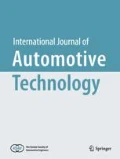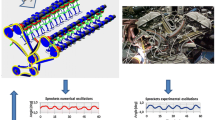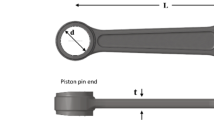Abstract
Ensuring engine efficiency is a crucial issue for automotive manufacturers. Several manufacturers focus on reducing the time taken to develop and introduce brand new vehicles to the market. Thus, a synergic approach including various simulations is generally adopted to achieve a development schedule and to reduce the cost of physical tests. This study involved proposing a design process that is very useful in the preliminary development stage through effective support from simulations. This type of simulation-based design process is effective in developing timing chain drives; the use of this process, based on results from multiple trials, showed improvements in performance including low friction and vibration, improved durability, and cost-effective part design when compared to conventional processes. This study proposes an integrated approach to the preliminary design of an automotive timing chain system. The approach involves structural and dynamic analyses. The details of the design process are described by using the case of a virtual engine. This study conducted and summarized a dynamic and structural analysis as well as topological optimization to describe a process to obtain optimal results. The results of this study indicated the following improvements in overall performance factors: 12.1 % improvement in transmission error, 10.1 % reduction in chain tension, 46 % reduction in tensioner arm weight, and 11 % reduction in transversal displacement.
Similar content being viewed by others
References
ABAQUS (2011). ABAQUS Documentation. Dassault Systèmes. Providence, RI,USA.
Calabretta, M., Cacciatore, D., Carden, P. and Plail, J. (2011). Development of a timing chain drive model for a high speed gasoline engine. SAE Int. J. Engines 4, 1, 432–440.
Cubberly, W. H., Baker, H., Benhamin, D. and ASM International Handbook Committee. (1979). Metals Handbook, Vol. 2. Properties and Selection: Nonferrous Alloys and Pure Metals. American Society for Metals. Ohio, USA.
Fuglede, N. and Thomsen, J. J. (2016). Kinematics of roller chain drives -Exact and approximate analysis. Mechanism and Machine Theory, 100, 17–32.
International Standards Office (2004). ISO 10823:2004, Guidelines for the Selection of Roller Chain Drives, Geneva: ISO.
International Standards Office (2005). ISO 13203:2005, Chains, Sprockets and Accessories -List of Equivalent Terms, Geneva: ISO.
International Standards Office (2006). ISO 1275:2006, Double-pitch Precision Roller Chains, Attachments and Associated Chain Sprockets for Transmission and Conveyors, Geneva: ISO.
International Standards Office (2015). ISO 606:2015, Short-pitch Transmission Precision Roller and Bush Chains, Attachments and Associated Chain Sprockets, Geneva: ISO.
Morrison, R. A. (1952). Polygonal action in roller chain drive. Machine Design 24, 9, 155–159.
Priebsch, H. H., Herbst, H., Offner, G. and Sopouch, M. (2004). Numerical simulation and verification of mechanical noise generation in combustion engines. ISMA2004 Conf.
Sakaguchi, M., Yamada, S., Seki, M., Koiwa, Y., Yamauchi, T. and Wakabayashi, T. (2012). Study on reduction of timing chain friction using multi-body dynamics. SAE Paper No. 2012-01-0412.
Schoeffmann, W., Truffinet, C., Howlett, M., Ausserhofer, N. and Zurk, A. (2015). Demands on future timing drives -Chain and belt in competition. SAE Paper No. 2015-01-1275.
Song, I., Choi, J., Ryu, H. and Bae, D. (2003). Nonlinear dynamic modeling and analysis of automotive silent chain drive. Fall Conf. Proc., Korean Society of Automotive Engineers, 1067–1072.
Sopouch, M., Hellinger, W. and Priebsch, H. (2002). Simulation of engine's structure borne noise excitation due to the timing chain drive. SAE Paper No. 2002-01-0451.
Takagishi, H., Muguruma, K. and Takahashi, N. (2008). Analysis of effect of tensioner on chain system. SAE Paper No. 2008-01-1496.
Author information
Authors and Affiliations
Corresponding author
Rights and permissions
About this article
Cite this article
Jung, T., Park, Y., Kim, Y.J. et al. Integrated approach to an optimal automotive timing chain system design. Int.J Automot. Technol. 18, 1037–1045 (2017). https://doi.org/10.1007/s12239-017-0101-x
Received:
Revised:
Accepted:
Published:
Issue Date:
DOI: https://doi.org/10.1007/s12239-017-0101-x




